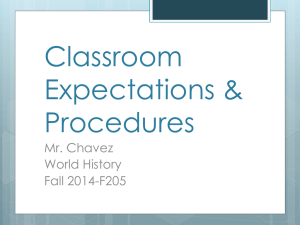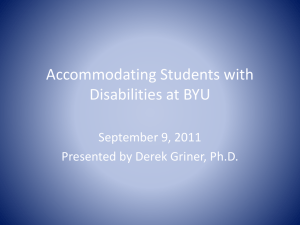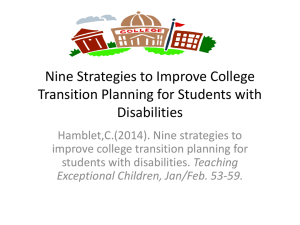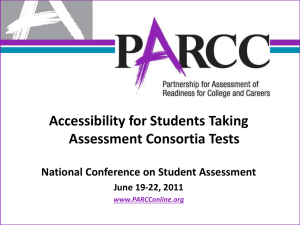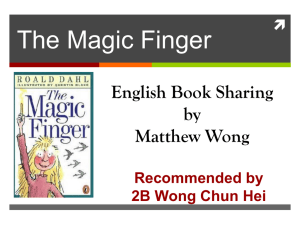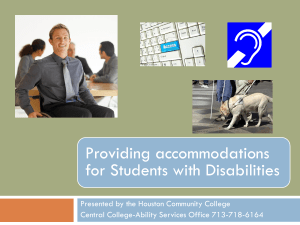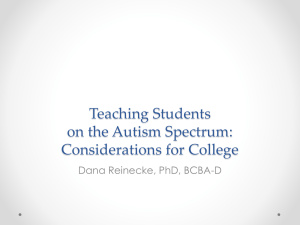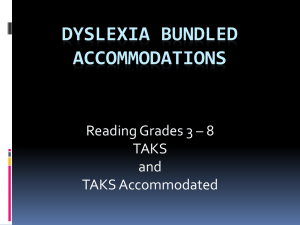Motor Planning Training
advertisement
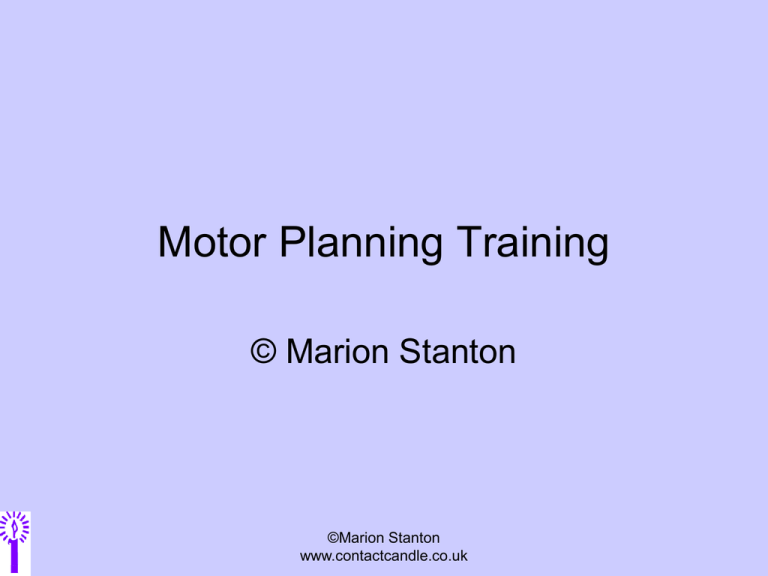
Motor Planning Training © Marion Stanton ©Marion Stanton www.contactcandle.co.uk Practical activity – the value of support • Write with your dominant hand standing on one leg. • Get someone to hold you steady and then repeat writing. ©Marion Stanton www.contactcandle.co.uk Motor Planning • Learning to drive, swim dance. ©Marion Stanton www.contactcandle.co.uk Most Common types of Neuro-Motor Difficulties. Autism Cerebral Palsy Proprioception Involuntary Movement Perseveration Muscle Tone Impulsivity Initiation Initiation ATNR Disinhibition Radial Ulnar Aksathisia Proximal Instability Dystonia Most Common types of Neuro-Motor Difficulties. Retts Down Syndrome Dystonia Impulsivity Fluctuating tone Low muscle tone Eye hand coordination Fatigue Initiation Eye/hand coordination Switching Finger isolation/extension Finger isolation Unstable sitting position ATNR ATNR (asymmetrical tonic neck reflex) A reflex extension of the arm following the pointed direction of the chin when turning the head to one side. Accommodation Encourage the person to look up until the last moment when they go to point. Impaired eye/hand co-ordination A person points without looking or without allowing enough time between movements to scan the display and locate the target. Some people cannot look and point at the same time e.g. with ATNR. Some people maintain that they find it easier to use peripheral vision but people often become more accurate and more independent if they develop their looking skills. Accommodations Hold back until the person has looked. Ensure aids are appropriately positioned to make it as easy as possible for the person to look and point. Perseveration The person repeats previous selection or tends towards certain selections. Looks like repetitive behaviour. Accommodations Bring the person back to a central point between each selection. Shake the arm every few selections. Change positions on the communication board. Radial/Ulnar Stability Unequal pull on muscles. Accommodation The muscles in the hand, wrist or forearm do not co-ordinate well together causing the index finger to swerve resulting in Temporary use of a splint. selections off to the side of the target Use the hand that facilitates as a splint. Body Stability Proximal instability Shoulder and/or trunk instability due to muscle weakness. Often an over arm pointing action is used. Unstable sitting position Muscle weakness spinal problems. and/or Accommodations Good supportive seating Supportive clothing Lifting the side that sags. Akathisia Described as a sense of ‘inner restlessness’, that has a strong component of motor restlessness. The person cannot keep physically still or maintain a static posture for an extended period of time. Accommodations Let the person have frequent movement breaks. Use ‘fidget’ toys. Use timer for time to be on task. Crossing the midline Difficulty crossing over the mid point of one’s body when pointing. Accommodations Position the aid to the right (left for left handed people) Centre the aid in line with shoulder. Provide firmer hold, resistance, lift on selections that are cross the mid line. Impulsivity The person points before they have had time to consider a response often without good aim. Accommodations Hold back until they have looked. Make sure they relax before they point. Talk quietly. Backward resistance. Tremor Can be either a continuous tremor or extension tremor. Accommodation Firm pressure in the facilitators hand. Disinhibition Auditory – cannot Accommodations Visual – cannot ignore Physical and verbal support to keep focus on target. ignore stimuli. stimuli. Reduce external stimuli when appropriate/necessary. Initiation Problems with starting a movement. Accommodations Verbal prompts ‘1,2,3 go’. Slight physical prompt under the arm. Pulling back the forearm to bring in some tension. A gentle shake of the arm. Proprioception Lacks awareness of themselves in space. May be recognised by people trying to get contact with large surface areas. Sometimes repeated physical behaviour. Accommodation Lean against the body. Second skin. Gentle, deep pressure on hand, arms, shoulders. Chair with sides. Weights. Dystonia Slow, rhythmic, twisting involuntary muscle contractions, which force the body into abnormal, sometimes painful movements or postures. Dystonia can affect any part of the body including the arms, legs, trunk, neck, eyelids, face or vocal cords. Accommodation WAIT. Dystonia is painful and involuntary but it does pass. Gentle massage may help. Low Muscle Tone Hypotonia Floppy muscles making it difficult to lift limbs and put physical pressure on anything. Accommodations Lower the aid, give the arm a lift, pull back to create tension and increase tone. High Muscle Tone Hypertonia Having very tight muscles making it difficult to be accurate when pointing, sometimes over shooting target and pushing aid away due to force of movement. Accommodations Give arm a gentle shake/gentle massage. Position the aid directly in front. Involuntary Movements Difficulty in controlling part or parts of the body. Occasionally person will have better control of their head rather than their hand. Accommodations Anchoring (either with facilitation or supports) so that person is trying to move from the elbow rather than the whole arm or whole body. Try to establish a part of the body that the person has control over. Stopping Difficulty in stopping thoughts and movements once started. Accommodations Pull back to slow movements. Coactively stop the person to give a model Verbal prompting Finger Isolation/extension Difficulty isolating and/or extending an index finger. Instability at base of index finger – causes difficulty extending the index finger whilst flexing the other fingers. Accommodations Hand moulding Activities which encourage index finger isolation. Avoid crooking your finger under the persons finger. Occasional use of a finger splint. Undecided hand dominance Using both hands for a task only requiring one. Both hands come up at once and it is hard to isolate one from the other. Accommodations Find out if anyone in family is left handed. If not encourage right handed dominance. Vision Issues Difficulty scanning the communication aid. People with visual spatial impairments have great difficulty localising objects in 2 and 3D space. Accommodations Use good contrast. Experiment with position of aid. Try different sized/coloured pictures. Tactile Sensitivity Sensitivity to soft physical touch. Even the thought can be distressing. Accommodations A firm hold is better. Sensitive receptors are in the surface of the skin. Give the person verbal prompts. Let them know what is going to happen. Fatigue Muscles tire from repetitive use, over/lack of use or from intense amount of concentration used in achieving task. Accommodations Work at the person’s best time of day. STOP at regular intervals to allow for recovery. Carry on from the last point rather than going back to the beginning. VALIDATION • No claim of authorship without validation either by independent verification or other means. • Other means include information that the communication partner couldn’t have known. Doesn’t have to be the truth but needs to refer to something that has happened. ©Marion Stanton www.contactcandle.co.uk Strategies to develop independence • Slowly fade support • Help with timing using verbal prompts or other cues. • Ensuring switch users have the best set up for them. • Ensure those who eye-point look at you immediately after they have made a selection. • Make sure the spacing of selections is the most suitable for individual need. • Use the ladder. • MONITOR EYE CONTACT. ©Marion Stanton www.contactcandle.co.uk Monitoring access ©Marion Stanton www.contactcandle.co.uk ©Marion Stanton www.contactcandle.co.uk ©Marion Stanton www.contactcandle.co.uk Moving back to earlier strategies When: • New support staff • Less predictable or more complex text • New communication aid • Not well or tired or tense for any reason • In a test situation or when being watched by unfamiliar people • Subtle attempts to fade back are noticed! ©Marion Stanton www.contactcandle.co.uk Connection between FC/FCT and MPT • • • • • The name change Prejudice Poor practice Connection to accepted practice Discussion ©Marion Stanton www.contactcandle.co.uk CONTACT • www.candleaac.com • info@candleaac.com ©Marion Stanton www.contactcandle.co.uk

